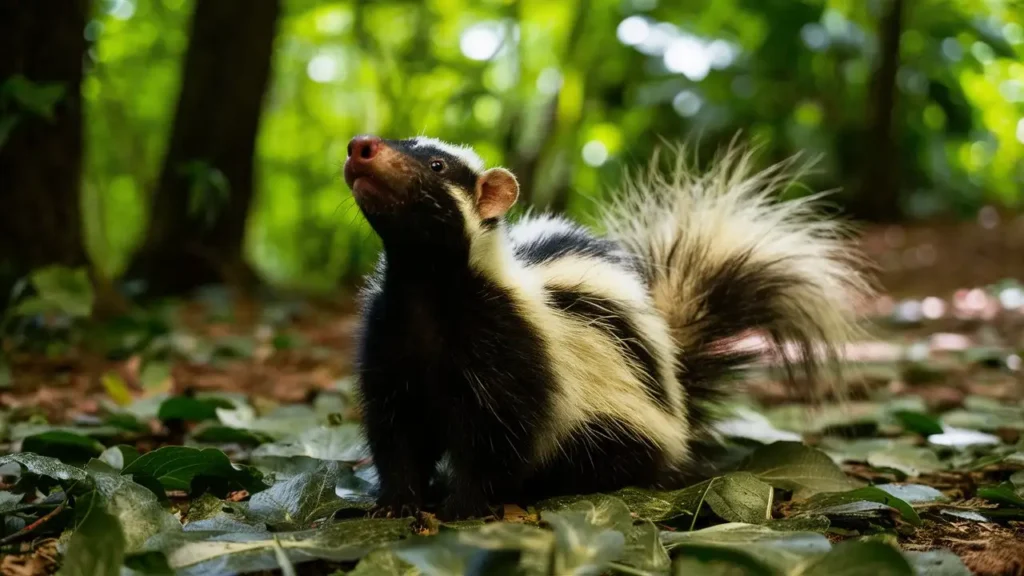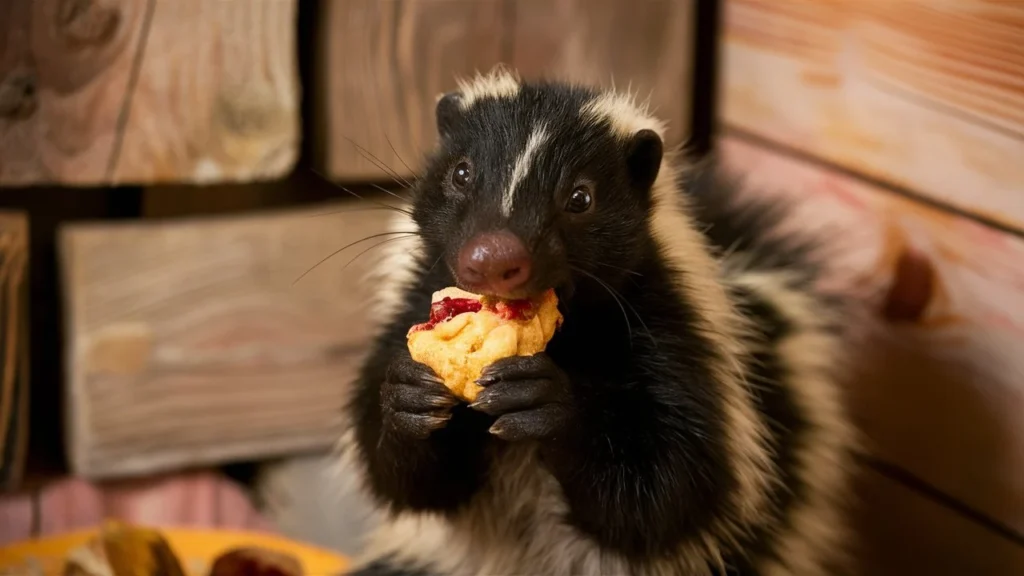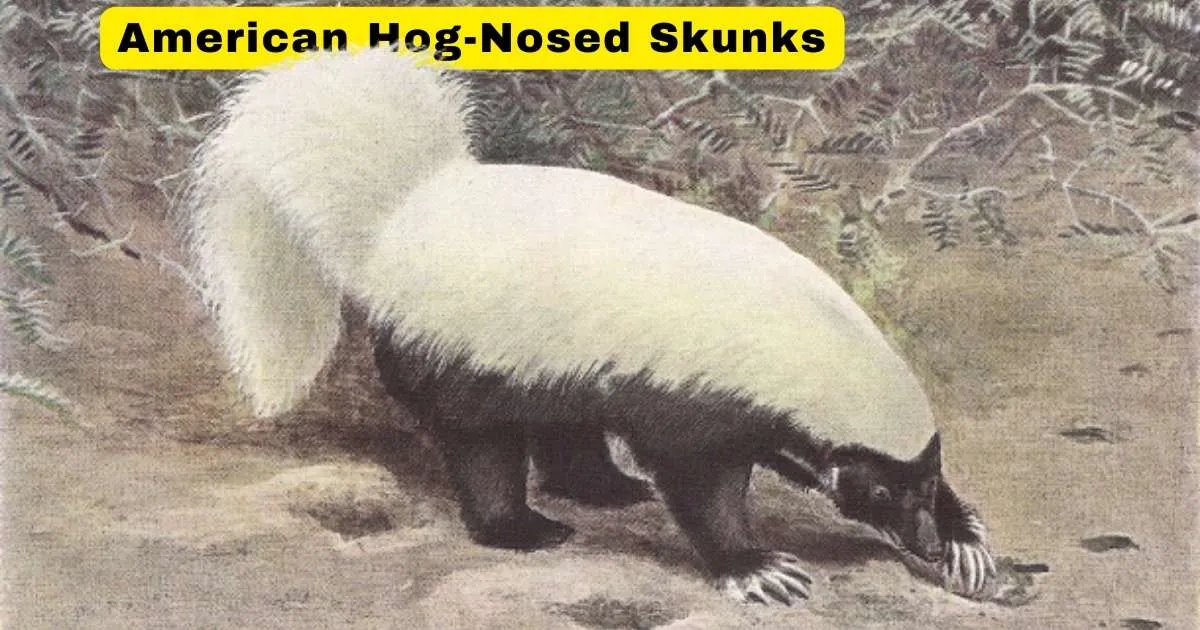American Hog-Nosed Skunk: A Fascinating Nocturnal Forager
Have you ever seen a skunk with a long, pig-like nose? Meet the American Hog-Nosed Skunk! This unique creature, native to North and Central America, is known for its exceptional digging skills and striking black-and-white appearance. Preferring the cover of night, it forages for insects, small animals, and plants while employing a potent spray for defense. Let’s dive into the intriguing world of this fascinating animal.
Introduction to the American Hog-Nosed Skunk
The American Hog-Nosed Skunk, scientifically known as Conepatus leuconotus, stands out among skunks due to its large size, bold stripe pattern, and characteristic nose designed for rooting in the soil. It’s a vital part of its ecosystem, contributing to pest control and soil health through its foraging habits.
Habitat and Distribution
The American Hog-Nosed Skunk thrives in a variety of habitats, including woodlands, grasslands, and scrubby areas. Its range extends from the southern United States, through Mexico, and into parts of Central America. It often lives near human settlements, leading to occasional encounters.
Preferred habitats include areas with dense vegetation for cover, ample food sources, and access to water. These adaptable mammals can make their homes in forests, open fields, or rocky terrains.
Physical Features and Adaptations
The American Hog-Nosed Skunk’s physical traits are perfectly suited for its lifestyle. Its broad, fleshy nose is ideal for digging, while its long claws allow it to unearth food buried deep in the soil.
- Size: One of the largest skunk species.
- Fur Pattern: A bold white stripe running down its back, contrasting with jet-black fur.
- Legs and Claws: Strong and designed for excavation.
- Defense Mechanism: Glands produce a sulfur-based spray to deter predators.
These adaptations ensure survival in varied environments, from forest floors to arid scrublands.
Dietary Habits
The American Hog-Nosed Skunk has an omnivorous diet, making it a versatile forager. Its meals include:
- Insects: Beetles, ants, and wasps.
- Small Animals: Rodents, frogs, and lizards.
- Plants: Fruits, seeds, and roots.
- Eggs: Bird eggs when available.
Using its keen sense of smell, the skunk detects food beneath the surface, then digs it out with precision. Its nocturnal foraging ensures it avoids competition and predators.

Behavior and Social Structure
American Hog-Nosed Skunks are solitary animals, coming together only during the mating season. They are nocturnal, emerging at dusk to forage and returning to dens before dawn.
Territorial Behavior
These skunks are highly territorial, marking their boundaries with scent to deter intruders. They rely on their potent spray as both a warning and a last resort defense.
Reproduction
Mating occurs in late winter to early spring. After a gestation period of about two months, females give birth to litters of two to four kits. The mother provides care and protection until the kits are old enough to fend for themselves.
Defense Mechanisms
The American Hog-Nosed Skunk’s spray is one of the most effective defense systems in the animal kingdom. This noxious chemical, produced in glands near its tail, can be sprayed with accuracy up to 10 feet. The spray causes irritation and deters predators like coyotes and foxes.
Before spraying, the skunk performs warning behaviors such as stomping its feet, raising its tail, and arching its back. These signals give potential threats a chance to back off before facing the skunk’s chemical arsenal.
Conservation Challenges
Despite their adaptability, American Hog-Nosed Skunks face several threats:
- Habitat Loss: Urbanization and agriculture reduce their natural habitats.
- Human Conflicts: Road accidents and pesticide exposure pose risks.
- Illegal Hunting: Though not common, they are sometimes hunted for their fur.
Conservation Efforts
Efforts to protect these skunks include habitat preservation, education campaigns to reduce human-skunk conflicts, and wildlife corridor projects that connect fragmented habitats.

Fun Facts About American Hog-Nosed Skunks
- Expert Diggers: They can dig up to three feet deep in search of food.
- Selective Sprayers: They conserve their spray and use it only when absolutely necessary.
- Role in Ecosystems: They control pest populations and aid in seed dispersal, making them vital to their environment.
Frequently Asked Questions
What do American Hog-Nosed Skunks eat?
They eat insects, small rodents, frogs, fruits, seeds, and occasionally bird eggs.
Where do American Hog-Nosed Skunks live?
They inhabit North and Central America, thriving in grasslands, forests, and scrubby areas near water sources.
How do American Hog-Nosed Skunks defend themselves?
They use a potent sulfur-based spray as a last-resort defense mechanism, along with warning behaviors like stomping and tail-raising.
Conclusion
The American Hog-Nosed Skunk is a remarkable animal that showcases nature’s adaptability. Its unique traits, from its digging prowess to its chemical defense, make it an essential player in its ecosystem. Protecting these skunks ensures the preservation of their habitats and the ecological balance they help maintain. By learning about them, we can appreciate the critical role they play in the natural world.nosed skunk reveals a creature of intrigue. Their diet, from insects to small rodents, showcases adaptability. Behavior patterns, such as nocturnal foraging, underscore survival skills. This skunk’s unique traits and role in ecosystems are vital. Embrace these curious facts and appreciate nature’s diversity.

